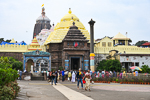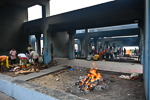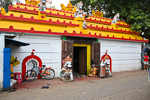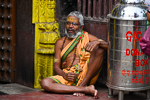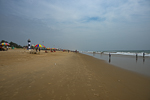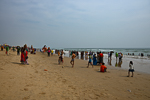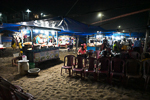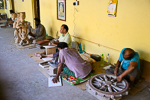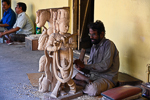Puri, Odisha, India (Nov 2022)
Puri, a noisy, congested pilgrimage city, would seem to have little to commend itself to a dyed-in-the-wool atheist / nastika like me, except anthropological curiosity still lures me to places that provoke extreme devotion in people. Puri's famous Jagannath Temple is one such site. Built in the 12th century, precursors of its annual Rath Yatra appear in sculpture over a thousand years ago (incidentally, the wooden Rath, from which comes the word juggernaut, is constructed anew each year). This festival astonished medieval travelers like Francois Bernier, who recorded the following in 1667 CE:
In the town of Jagannat ... containing the famous temple of the idol of that name, a certain annual festival is held ... for the space of eight or nine days. At this festival is collected an incredible concourse of people ... as happens at present in the city of Mecca. The number, I am told, sometimes exceeds one hundred and fifty thousand. A superb wooden machine [with] many grotesque figures . . . is set on fourteen or sixteen wheels like those of a gun-carriage, and drawn or pushed along by the united exertions of fifty or sixty persons. The idol, Jagannat, placed conspicuously in the middle, richly attired, and gorgeously adorned, is thus conveyed from one temple to another . . . blindly credulous [people] throw themselves upon the ground in the way of its ponderous wheels, which pass over and crush to atoms the bodies of the wretched fanatics without exciting the horror or surprise of the spectators. No deed, according to their estimation, is so heroic or meritorious as this self-devotion: the victims believe that Jagannat will receive them as children, and recall them to life in a state of happiness and dignity. The Brahmens encourage and promote these gross errors and superstitions to which they are indebted for their wealth and consequence.
We queued up to enter the temple with a throng of devotees chanting 'jai jagannath', all jostling for a closer look at their beloved deities. Copious legends surround Lord Jagannath, including about his origins as a tribal deity—illustrating Brahminism's age-old colonizing process in which the gods of the forest peoples, as with Kali and Shiva, are embraced and Sanskritized to bring their followers into the Brahminical socio-religious orbit (this work continues, including by RSS's Vanvasi Kalyan Ashram). The temple complex is thus significant both as a historical-cultural site (it has nice sculptural flourises too; sadly, no photography inside) and for being home to a deity that local Brahminical elites have appropriated and made central to Odia identity and sub-nationalism.
The city's main beaches are nice enough, though the beachfront scene mainly caters to the pilgrims who come year-round in large numbers (no competition to Goa). Alcohol is not hard to find in this holy city, the locals I met were generous, their government isn't run by Hindutva goons, and Puri's train station is among the best in the country (with a layout similar to European stations).
The famous Jagannath |
"Swargadwar" |
"Swargadwar" |
A contemporary temple |
A priestly type |
Golden Beach |
Golden Beach |
Crowded Golden Beach |
Evening fast food joints |
Seafood on the beach |
A market area |
Another ordinary temple |
Basanta Road scene |
Sugarcane juice stand |
Narendra Tank, |
Chandan Yatra Info |
Artists at the Sudarshan |
Sculptor |
Carvings in stone, |
Sculpting a goddess |
Designed in collaboration with Vitalect, Inc. All rights reserved. |









